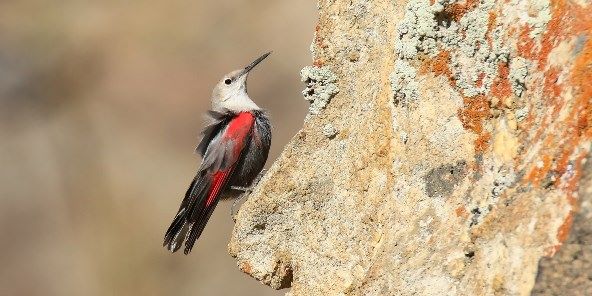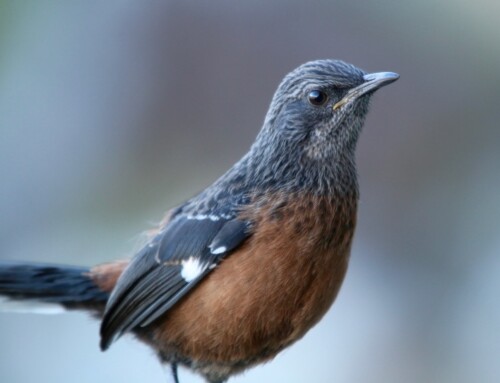Which species are ‘mountain birds’ and what is their status in a fast-changing environment?
LINKED PAPER
A review and meta-analysis of the effects of climate change on Holarctic mountain and upland bird populations. Scridel, D., Brambilla, M., Martin, K., Lehikoinen, A., Iemma, A., Matteo, A., Jähnig, S., Caprio, E., Bogliani, G., Pedrini, P., Rolando, A., Arlettaz, R. & Chamberlain, D. 2018. IBIS. DOI: 10.1111/ibi.12585. VIEW
Mountain and high-latitude upland regions (henceforth ‘mountains’) cover around 25% of the Earth’s surface and are considered globally important areas for birds and biodiversity, supporting ¼ of terrestrial biodiversity and containing about 50% of the world’s biodiversity hotspots. Mountains are also experiencing a faster rate of climate change than the global average and are subject to other landscape-scale anthropogenic changes, raising serious concerns for high-elevation biodiversity. For these reasons, we gathered a group of international experts to review the current state of Holarctic mountain birds facing climate and environmental change.
A fundamental requirement when writing a review is to clearly identify your study subject. We immediately realised that defining a mountain (and a mountain bird) was a steep mountain to climb! Indeed, a clear definition of what distinguishes a mountain from a hill is under constant debate, as this varies according to local perceptions. Whilst there are not doubts that the highest peaks, such as Mount Denali (6.190m), Mont Blanc (4.809m), Everest (8.848m), and Mount Elbrus (5.642m), are mountains, for lower elevation ranges a classification is more ambiguous. For example, some countries consider peaks that are few hundred meters high as mountains, as in the case of Mount Wycheproof (148m) in Australia or Suur Munamägi (318m) in Estonia. Using elevation thresholds alone to define mountain regions would therefore exclude older and lower elevation mountain systems, such as the Urals, Scottish Highlands and Appalachians. For these reasons, we adopted the definition of Kapos et al. (2000) who classified mountain systems in seven classes based on the interactive effects of climate, elevation, latitude and land use (Fig. 1). We then defined as a ‘high-elevation mountain specialist’ a bird species for which at least 50% of its Holarctic breeding range was in the higher elevation classes and a ‘mountain generalist’ as a species for which at least 50% of its entire distribution was within the defined Holarctic mountain region. This definition helped solve the problem of the effect of latitude, (i.e. many species that are mountain birds at warmer (i.e. lower) latitudes are lowland species at higher, colder latitudes. For example, Western Capercaillie Tetrao urogallus, Eurasian Pygmy Owl Glaucidium passerinum, Rock Ptarmigan Lagopus muta occur in mountains at low latitudes (e.g. European Alps, Pyrenees), but occupy lower elevations at higher latitudes (e.g. Fennoscandia, Russia). These calculations identified that out of the 2316 bird species breeding in the Holarctic realm, 818 (35.3%) can be considered mountain birds, of which 324 species were high-elevation specialists and 494 mountain generalists. In general, the species identified as high-elevation specialists or mountain generalists were in line with what we expected, although there were some surprising results. For example, Rock Ptarmigan is considered an archetypal mountain bird in many parts of its range (the European Alps, the Pyrenees, British Columbia and Alberta) but not according to our definition. This may have been partly due to the coarse scale of the defined breeding range, but it also reflects the widespread populations of this species inhabiting lowland Arctic tundra (e.g. Rock Ptarmigan occur close to sea level in the extremities of North America such as the Aleutians, northern Quebec and Newfoundland).


When we created a list of the most studied species, the winners were White-winged Snowfinch Montifringilla nivalis, Alpine Chough Pyrrhocorax graculus and Wallcreeper Tichodroma muraria. However, when excluding studies based solely on distributional data (e.g. species distribution models), meta-analysis and reviews, only 2% of high-elevation mountain specialists and 14% of mountain generalist species had been investigated. This highlights our limited knowledge of birds inhabiting Holarctic mountain systems. From our literature review, it was evident that mountain species are still little-studied relative to species in lowlands. For many common species in mountains even basic biological and ecological knowledge is lacking (e.g. Alpine Accentor Prunella collaris, White-winged Snowfinch, Twite Linaria flavirostris, Wallcreeper, North American Rosy Finches Leucosticte spp.). Despite this, the available literature suggests that climate change may have potential effects on the reproduction, survival, population trends and distribution of mountain birds. These effects may be mediated by direct effects of climate on physiology (e.g., physiological stress can be observed for White-tailed Ptarmigan Lagopus leucura when experiencing a temperature of 21 °C), or indirect effects of changes in habitat or via interactions with other biotic and abiotic changes. However, patterns are highly variable (e.g. both increases and decreases in population size, range changes towards both higher and lower elevations) among species and across different study areas for the same species. For the future, our meta-analysis suggested that mountain species will be more negatively impacted than non-mountain species.

Various studies have also highlighted that the future distribution of birds are likely to occur in areas currently not protected, or will conflict with areas climatically and topographically suitable for the development of other infrastructures, particularly those linked to skiing. However, these species distribution models rarely included scenarios of changes in land use and human disturbance with those of climate change, and future work should aim to disentangle these two effects. We evaluated what authors suggested in terms of compensation adaptation responses for mountain species. We were surprised to see how protected areas may have already functioned as important compensatory systems, increasing species’ resilience to climate change. Some studies demonstrated that human activities can be beneficial for climate-sensitive species (i.e. some pastoral activities) and yet mechanization, leisure and urbanization may impede potential benefits. Major changes can occur if scientists and legislators work closely together, for example through the development of efficient agri-environmental schemes, forestry practices, regulation of leisure activities and sustainable urban planning in mountain areas, with explicit recognition of the general ecological requisites for wildlife persistence such as ensuring connectivity across their full life cycle.
Priorities for future research should include greater communication and collaboration among international scientists to fill research gaps, carry out more autecological studies (physiological tolerance, ecological requirements, trophic resources), better and more extensive monitoring of mountain areas, whilst aiming at disentangling effect of changes in land-use from climatic alterations. Finally, we invite scientists and policy-makers to develop and apply habitat restoration plans in mountain areas, particularly where climate change and changes in land use are likely to offer such opportunities in the near future (i.e. encroaching pastures after grazing/abandonment of ski-pistes, afforestation of native woodland on moorlands). Indeed, conservation and restoration frameworks have already been developed for various bird species inhabiting mountain regions considered susceptible to changes in climate and land use.
Acknowledgements
We thank all co-authors and Devin de Zwaan who have contributed with comments and photos to this post. We are also grateful to Jeremy Wilson, Paul Donald, James Pearce-Higgins, Thomas G. Gunnarsson and one anonymous reviewer for helpful comments and advice. We also acknowledge Alessandro Franzoi, Giacomo Assandri, Simone Tenan, Emanuel Rocchia & Frank La Sorte for general advice and comments. We thank Bill DeLuca, Fränzi Korner, Jeremy Mizel, Claire Pernollet, Veronika Braunisch, Jaime Resano Mayor and Morgan Tingley for help with the meta-analyses. The study was funded by Museo delle Scienze of Trento (MUSE – Italy) and by the Paneveggio-Pale di San Martino Natural Park (Italy) as part of Davide Scridel’s doctorate programme. Matteo Anderle’s contribution was funded by the Autonomous Province of Trento (Italy).
Further reading
Arlettaz, R., Nusslé, S., Baltic, M., Vogel, P., Palme, R., Jenni-Eierman, S., Patthey, P. & Genoud, .M. 2015. Disturbance of wildlife by outdoor winter recreation: allostatic stress response and altered activity-energy budgets. Ecol. Appl. 25: 1197–1212. VIEW
Brambilla, M., Caprio, E., Assandri, G., Scridel, D., Bassi, E., Bionda, R., Celada, C., Falco, R., Bogliani, G., Pedrini, P., Rolando, A., & Chamberlain, D. 2017. A spatially explicit definition of conservation priorities according to population resistance and resilience, species importance and level of threat in a changing climate. Divers. Distrib. 23: 727–738. VIEW
Kapos, V., Rhind, J., Edwards, M., Price, M. F. & Ravilious, C. 2000. Developing a map of the world’s mountain forests. In Price, M.F. & Butt, N. (eds) Forests in Sustainable Mountain Development: A State-of-Knowledge Report for 2000: 4–9. Wallingford: CAB International.
Lehikoinen, A., Green, M., Husby, M., Kålås, J.A. & Lindström, Å. 2014. Common montane birds are declining in Northern Europe. J. Avian Biol. 45: 3–14. VIEW
Martin, K., Wilson, S., MacDonald, E.C., Camfield, A.F., Martin, M. & Trefry, S.A. 2017. Effects of severe weather on reproduction for sympatric songbirds in an alpine environment: interactions of climate extremes influence nesting success. Auk 134: 696–709. VIEW
Potatov, R. 2004. Adaptation of birds to life in high mountains in Eurasia. Acta Zool. Sinica 50: 970–977. VIEW
Reif, J. & Flousek, J. 2012. The role of species’ ecological traits in climatically driven altitudinal range shifts of central European birds. Oikos 121: 1053–1060. VIEW
Scridel, D., Bogliani, G., Pedrini, P., Iemma, A., von Hardenberg, A. & Brambilla, M. 2017. Thermal niche predicts recent changes in range size for bird species. Clim. Res. 73: 207–216. VIEW
Image credit
Featured image: Wallcreeper, Tichodroma muraria | Imran Shah | CC BY-SA 2.0
Blog posts express the views of the individual author(s) and not those of the BOU.
If you want to write about your research in #theBOUblog, then please see here.





